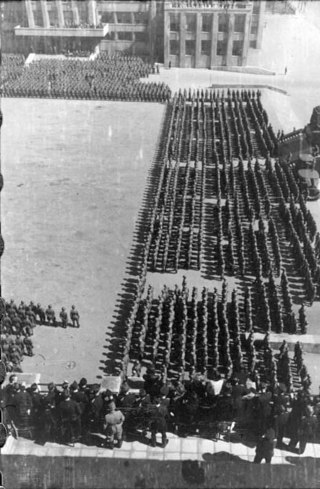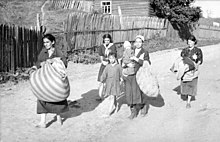
The Ordnungspolizei, abbreviated Orpo, meaning "Order Police", were the uniformed police force in Nazi Germany from 1936 to 1945. The Orpo organisation was absorbed into the Nazi monopoly on power after regional police jurisdiction was removed in favour of the central Nazi government. The Orpo was controlled nominally by the Interior Ministry, but its executive functions rested with the leadership of the SS until the end of World War II. Owing to their green uniforms, Orpo were also referred to as Grüne Polizei. The force was first established as a centralised organisation uniting the municipal, city, and rural uniformed police that had been organised on a state-by-state basis.

Kurt Max Franz Daluege was a German SS and police official who served as chief of Ordnungspolizei of Nazi Germany from 1936 to 1943, as well as the Deputy/Acting Protector of Bohemia and Moravia from 1942 to 1943.
There were two main Police forces of Nazi Germany under the Reichsführer-SS, Heinrich Himmler from 1936:
The 15th SS Police Regiment was initially named the 15th Police Regiment when it was formed in 1942 from existing Order Police units (Ordnungspolizei) to conduct security warfare behind the Eastern Front. The regiment was destroyed in January 1943 and its personnel was used to reconstitute it in Norway several months later from existing police units. The regiment was transferred to Italy in late 1943 and remained there for the rest of the war.

The Police Regiment Centre was a formation of the Order Police during the Nazi era. During Operation Barbarossa, it was subordinated to the Schutzstaffel (SS) and deployed in German-occupied areas, specifically the Army Group Centre Rear Area, of the Soviet Union. In mid-1942, its three constituent battalions were reassigned and the unit was re-designated as the 13th Police Regiment.
The Police Regiment South was a formation of the German Order Police, the German national uniformed police force, during the Nazi era. During Operation Barbarossa, it was subordinated to the Schutzstaffel (SS) and deployed in German-occupied territories, specifically the Army Group South Rear Area. In July 1942, its three constituent battalions were redesignated as the 10th Police Regiment.
The 5th SS Police Regiment was initially named the 5th Police Regiment when it was formed in 1942 from existing Order Police (Ordnungspolizei) units for security duties in Occupied Serbia. It was redesignated as an SS unit in early 1943. The regiment was disbanded at the end of 1944.
The 14th SS Police Regiment was initially named the 14th Police Regiment when it was formed in 1942 from existing Order Police units (Ordnungspolizei) for security duties on the Eastern Front. The regiment was destroyed in January 1943 and the survivors were used to rebuild it in Southern France several months later. The second incarnation was formed from existing police units. It was given an honorary SS title. Shortly before the end of the war, the regiment was absorbed into the 3rd SS Police and Infantry Regiment of the 35th SS and Police Grenadier Division.
The 16th SS Police Regiment was initially named the 16th Police Regiment when it was formed in 1942 from existing Order Police units for security duties on the Eastern Front. It was redesignated as an SS unit in early 1943.
The 17th SS Police Regiment was initially named the 17th Police Regiment when it was formed in 1942 from existing Order Police units (Ordnungspolizei) for security duties on the Eastern Front. It was redesignated as an SS unit in early 1943.
The 27th SS Police Regiment was initially named Police Regiment South Norway when it was formed in early 1941 after the German invasion of Norway in 1940 from existing Order Police units for security duties there. It was redesignated as the 27th Police Regiment in mid-1942 before it received the SS title in early 1943.
The Police Battalion 322 was a formation of the German Order Police during the Nazi era. During Operation Barbarossa, it was subordinated to the SS and deployed in German-occupied areas, specifically the Army Group Centre Rear Area, of the Soviet Union, as part of Police Regiment Centre.
The Police Battalion 307 was a formation of the Order Police during the Nazi era. During Operation Barbarossa, it was subordinated to the SS and deployed in German-occupied areas, specifically the Army Group Centre Rear Area, of the Soviet Union, as part of Police Regiment Centre. Alongside detachments from the Einsatzgruppen, it perpetrated mass murder in the Holocaust and was responsible for large-scale crimes against humanity targeting civilian populations. In mid-1942, the battalion was reassigned to the 23rd Police Regiment and operated in Belarus.
The Police Battalion 314 was a formation of the German Order Police during the Nazi era. During Operation Barbarossa, it was subordinated to the SS and deployed in German-occupied areas, specifically the Army Group Centre Rear Area, of the Soviet Union, as part of Police Regiment South. Alongside detachments from the Einsatzgruppen and the 1st SS Infantry Brigade, it perpetrated mass murder in the Holocaust and was responsible for large-scale crimes against humanity targeting civilian populations.
The Police Battalion 303 was a formation of the German Order Police during the Nazi era. During Operation Barbarossa, it was subordinated to the SS and deployed in German-occupied areas, specifically the Army Group Centre Rear Area, of the Soviet Union, as part of Police Regiment South. Alongside detachments from the Einsatzgruppen of the SD and the 1st SS Infantry Brigade of the Waffen-SS, it perpetrated mass murder in the Holocaust and was responsible for large-scale crimes against humanity targeting civilian populations.
The Police Battalion 45 was a formation of the German Order Police during the Nazi era. During Operation Barbarossa, it was subordinated to the SS and deployed in German-occupied areas, specifically the Army Group Centre Rear Area, of the Soviet Union, as part of Police Regiment South. Alongside detachments from the Einsatzgruppen of the SD and the 1st SS Infantry Brigade of the Waffen-SS, it perpetrated mass murder in the Holocaust and was responsible for large-scale crimes against humanity targeting civilian populations.
The Police Battalion 320 was a formation of the German Order Police during the Nazi era. During Operation Barbarossa, it was subordinated to the SS and deployed in German-occupied areas, specifically the Army Group South Rear Area, of the Soviet Union, as part of Police Regiment Special Purpose. Alongside detachments from the Einsatzgruppen of the SD, it perpetrated mass murder in the Holocaust and was responsible for large-scale crimes against humanity targeting civilian populations.
The Police Battalion 309 was a formation of the Order Police during the Nazi era. During Operation Barbarossa, it was subordinated to the German Army's 221st Security Division and deployed in German-occupied areas, specifically the Army Group Centre Rear Area, of the Soviet Union, as part of Wehrmacht's security forces. Alongside detachments from the Einsatzgruppen and the SS Cavalry Brigade, it perpetrated mass murders and was responsible for large-scale crimes against humanity targeting civilian populations.
The Police Battalion 306 was a formation of the Order Police during the Nazi era. During the Soviet-German war of 1941–45, it was deployed in German-occupied areas of the Soviet Union, as part of Nazi Germany's security forces tasked with "bandit-fighting". Alongside other SS and police units, it participated in the Holocaust and was responsible for large-scale crimes against humanity targeting civilian populations.

The Order Police battalions were militarised formations of the Nazi German Ordnungspolizei. During World War II, they were subordinated to the SS and deployed in German-occupied areas, specifically the Army Group Rear Areas and territories under German civilian administration. Alongside detachments from the Einsatzgruppen and the Waffen-SS, these units perpetrated mass murder of the Jewish population and were responsible for large-scale crimes against humanity targeting civilian populations.




